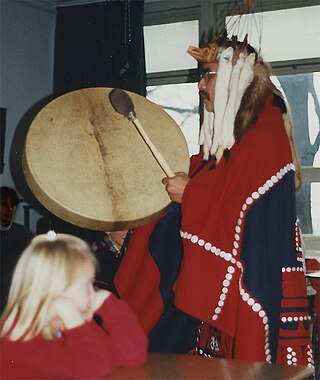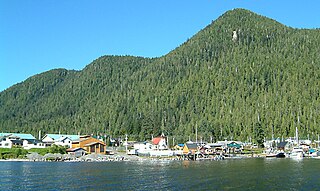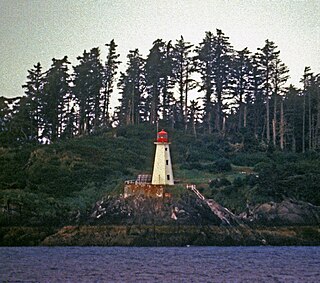
Prince Rupert is a port city in the province of British Columbia, Canada. Its location is on Kaien Island near the Alaskan panhandle. It is the land, air, and water transportation hub of British Columbia's North Coast, and has a population of 12,220 people as of 2016.

The Tsimshian are an Indigenous people of the Pacific Northwest Coast of North America. Their communities are mostly in coastal British Columbia in Terrace and Prince Rupert, and Metlakatla, Alaska on Annette Island, the only reservation in Alaska.
Pearse Island is an island in western British Columbia, Canada, in the Portland Inlet, an inlet of the Pacific Ocean. The island was first charted in 1793 by George Vancouver during his 1791-95 expedition. It was named by George Henry Richards, captain of HMS Plumper, circa 1860, in honour of William Alfred Rombulow Pearse of the Royal Navy, who had been commander of HMS Alert.

Kaien Island is a Canadian island on the coast of British Columbia, just north of the mouth of the Skeena River and to the south of the Alaska Panhandle. The island has an area of about 45 square kilometres, is roughly oval, and about 11 kilometres (6.8 mi) long along its long axis. The island consists of a central mountain ridge, surrounded by coastal lowlands, the dominant central peak is Mount Hays reaching 708 metres (2,323 ft), with a secondary peak, Mount Olfield reaching 555 metres (1,821 ft) to the northeast.

Khutzeymateen Inlet is one of the lesser principal inlets of the British Columbia Coast. It is important in being part of the first area in Canada protected to preserve grizzly bears and their habitat via the Khutzeymateen/K’tzim-a-deen Grizzly Sanctuary. The inlet and the park-sanctuary surrounding it are between the mouths of the Skeena and Nass Rivers; the Khutzeymateen is the next inlet north from Work Channel, which is the north side of the Tsimpsean Peninsula of "Greater Prince Rupert". The inlet's mouth opens onto an arm of Portland Inlet, Steamer Passage, which lies next to Sommerville Island. The entrance to Khutzeymateen Inlet is between Keemein Point and Welgeegenk Point. The closest community is Lax Kw'alaams, formerly Port Simpson.

Dodge Cove is a small unincorporated community of fewer than 100 people, located on Digby Island, British Columbia, Canada across from the city of Prince Rupert. In April 2015, the community had an estimated total of 29 residents. Dodge Cove does not have paved roads, automobiles or shopping centres, and was named in 1907 after George Blanchard Dodge. It was built over a Tsimshian village named Kanagatsiyot. A commercial ferry service has been proposed to service the area and other nearby communities. In contemporary times, construction of a liquefied natural gas facility was proposed, which some of the community's residents oppose.

Hartley Bay is a First Nations community on the coast of British Columbia. The village is located at the mouth of Douglas Channel, about 630 kilometres (390 mi) north of Vancouver and 145 kilometres (90 mi) south of Prince Rupert. It is an isolated village accessible only by air and water with a population of 200.

Lax-Kwʼalaams, previously called Port Simpson until 1986, is an Indigenous village community in British Columbia, Canada, not far from the city of Prince Rupert. It is located on Port Simpson Indian Reserve No. 1, which is shared with other residential communities of the Tsimshian Nation. The Nine Allied Tribes are: Gilutsʼaaw, Ginadoiks, Ginaxangiik, Gispaxloʼots, Gitando, Gitlaan, Gitsʼiis, Gitwilgyoots, and Gitzaxłaał.
Frederick Alexcee was a Canadian carver and painter from the community of Lax Kw'alaams with Tsimshian ethnicity.

Porcher Island is an island in Hecate Strait, British Columbia, Canada, near the mouth of the Skeena River and southwest of the port city of Prince Rupert. The locality of Porcher Island is located near the island's northern tip at Humpback Bay, 54°05′11″N130°23′23″W. Stephens and Prescott Islands are located off its northwestern tip.

Banks Island is an island on the coast of the Canadian province of British Columbia. It is located south of Prince Rupert, on Hecate Strait, east of and opposite Haida Gwaii. To its east is Pitt Island and McCauley Island, both across Principe Channel. To its west is Bonilla Island. To its south lies the archipelago of the Estevan Group, beyond which is Caamaño Sound.
Dundas Island is an island on the North Coast of British Columbia, Canada, on the west side of Chatham Sound to the northwest of Prince Rupert. It is the largest of a group of islands known as the Dundas Islands.
Caamaño Passage is a strait on the North Coast of British Columbia, Canada, located between Dundas and Zayas Islands on the west side of Chatham Sound near Prince Rupert.
Barrett Point is located at the foot of Mount Hayes at the entrance to Prince Rupert Harbour at 54°14′28″N130°20′02″W. It was a coastal fortification during World War II.
Zayas Island is an island on the North Coast of British Columbia, Canada, located in the east side of Dixon Entrance to the west of Dundas Island. Three parcels of land on the north, east and south shores of the island are reserves of the Lax Kw'alaams First Nation.

The Lucy Islands are a small archipelago off the North Coast of the province of British Columbia in Canada. The low-lying and heavily forested group, named after its largest island, Lucy Island, constitutes a provincially protected conservancy area that contains some of the North Coast’s oldest archeological sites, a nationally significant seabird population, and a prominent 20th-century lighthouse.
Fairview Point is a point or headland on the west side of Kaien Island on the North Coast of British Columbia, Canada.
George Blanchard Dodge (1874-1945) was a civil engineer and a surveyor with the Canadian Department of Crown Lands.

The Museum of Northern British Columbia is a museum in Prince Rupert, British Columbia, Canada.











